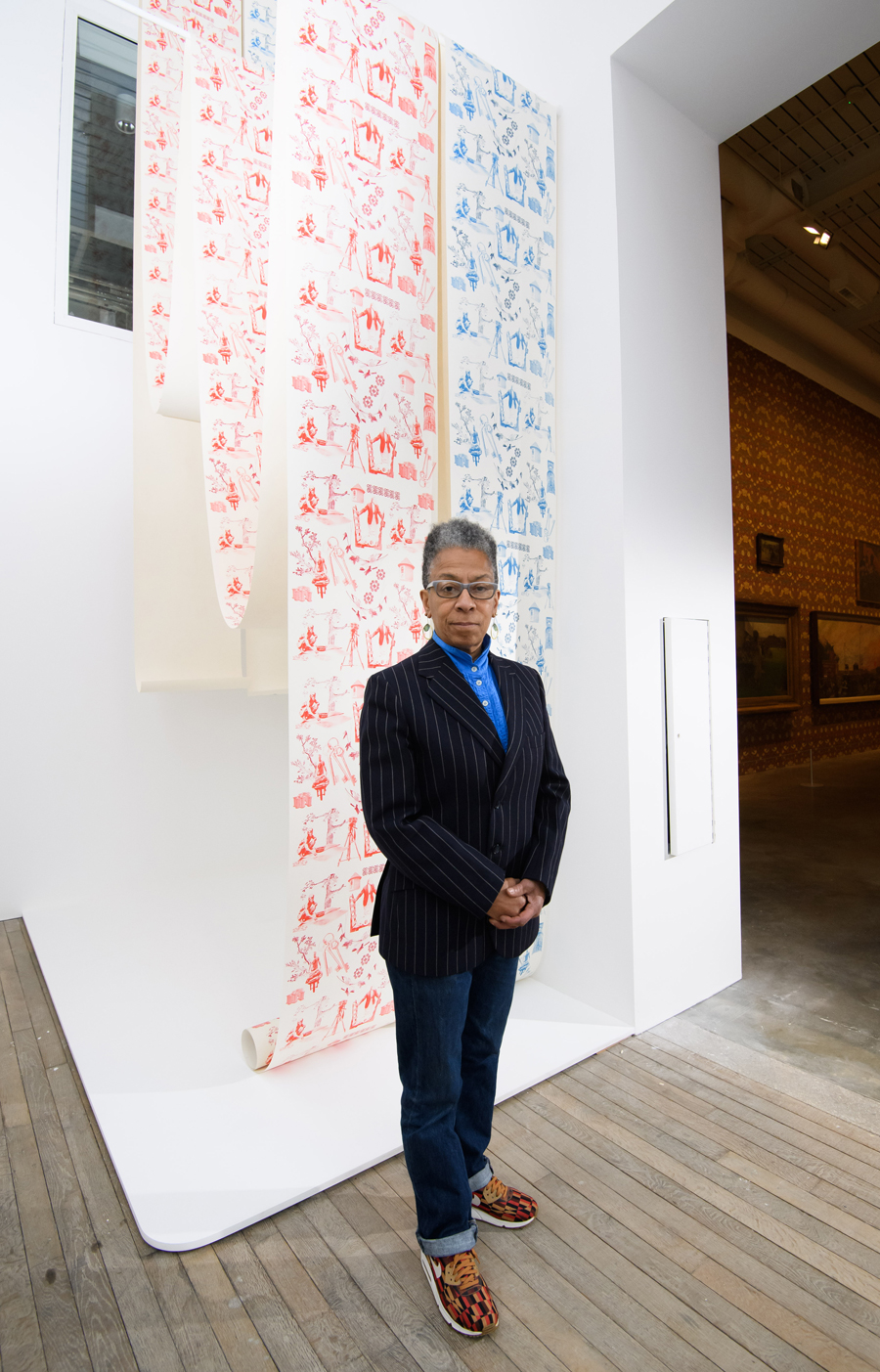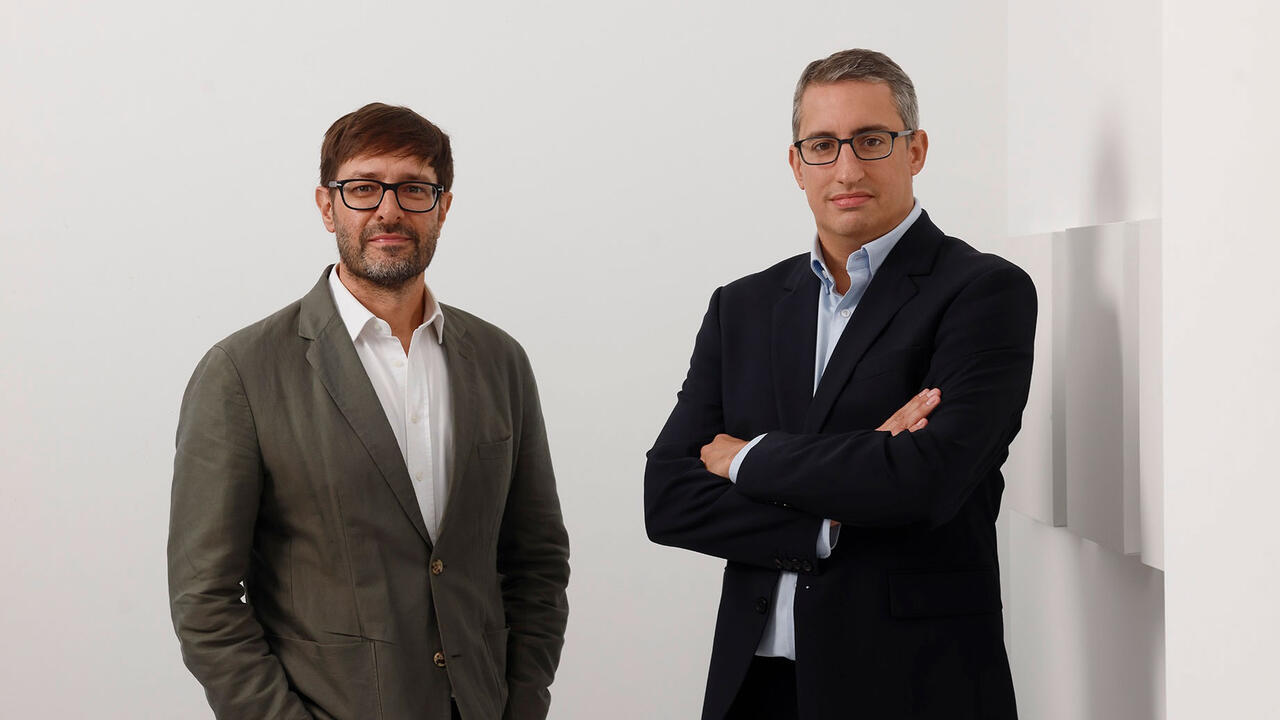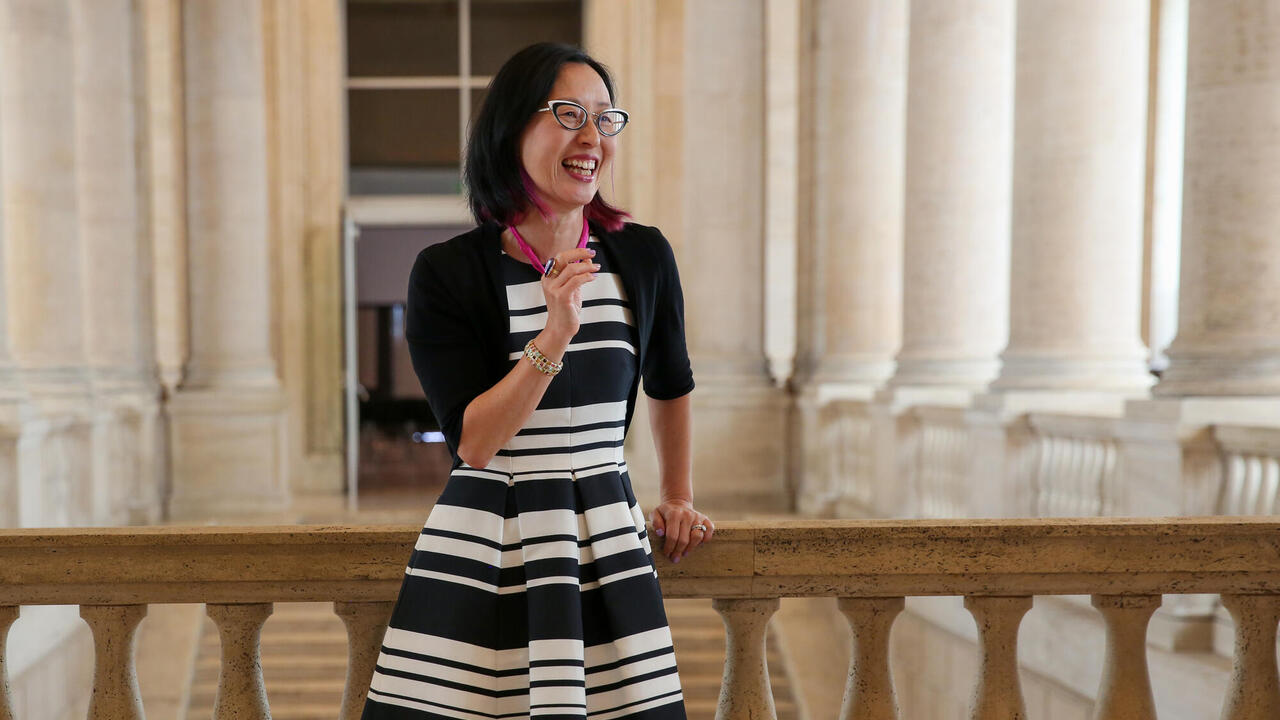Big Strong Polemics: Ingrid Pollard’s Photographs
Two UK exhibitions feature works in which the London-based artist engages with the British landscape
Two UK exhibitions feature works in which the London-based artist engages with the British landscape

In ‘The Lie of the Land’ at MK Gallery in Milton Keynes, two works made over 25 years apart raise discomforting questions about the exclusion and exploitation that created and maintains what we have come to think of as the natural landscape. The Cost of the English Landscape (1989) combines original photographs and text with postcards and walkers’ maps of the Lake District. Inviting imagery of this celebrated beauty spot are interspersed with warning signs from the nearby nuclear power plant, suggesting a landscape riven with tensions and centuries of human intervention. Pollard’s printed fabric Toile de Jouy There was Much Interruption (2015–18) updates the French textile tradition in which picturesque depictions of rural labour were used to decorate the homes of the landed gentry, with a pattern referencing the production and printing of the cotton itself.
At BALTIC in Gateshead, Seventeen of Sixty Eight (2018-19) is shown in the context of the biennial Baltic Artists Award, for which Pollard is one of three nominees. The culmination of decades of research into vernacular iconography and rural myth, the multi-part work uses historical references to the ‘Black Boy’ in British place names and pub signs in order to question how landscape and the figures within it are framed. The artist collective Radclyffe Hall recently included earlier photographic works by Pollard in their exhibition of celebratory and erotic lesbian photography from the 1970s and 80s ‘Deep Down Body Thirst’: first shown as part of Glasgow International in 2018, the exhibition is scheduled for a London outing later this year (location still to be disclosed). We met to talk about the body and the landscape over tea and Brazilian paçoca sweets at Camden Arts Centre in North London.

Hettie Judah: I’m interested in how you’ve approached photographing landscape. In the past you’ve made a series of long panoramic photographs, others that are hand-coloured. They express a lot about the relationship with what you’re looking at and how you’re seeing it.
Ingrid Pollard: You can look at the landscape as a working environment that’s very managed and not natural at all. The very romantic, nostalgic view expresses more about society’s understanding of what’s important, what to preserve. It’s also [connected to] relationships to other landscapes across the sea and how that’s changed in the last 500 years. You’ve got to look at landscape in the wider sense.
HJ: I was thinking about the relative politics of looking up or down at things: of that tradition where you portray figures surveying a landscape as if to say: ‘This is my domain!’
IP: It’s not just looking at it. It is very much about claiming it! Then there are people digging in the background: what’s their view, looking at the soil and the seeds?
HJ: Is that something that you've consciously explored?
IP: Yes, particularly using the panoramic, so that you have that breadth of looking: you really look closely and notice something a little strange going on. There was a panorama from the Lake District in which I had a figure with a camera right in the middle, so you weren’t allowed to have an easy view. People kept saying to me: ‘If you just got that person out the way!’ Their pleasure, this mindless pleasure, was suddenly stopped. They had to think about what they were looking at. The scene behind was a harbour and they could see the harbour walls, the housing estate, the camping site. Everything about it was made: it wasn’t natural landscape at all.
HJ: Thinking about how things have changed in relation to the rural, the whole rhetoric around Brexit has exacerbated that sense of London being an island away from the rest of Britain.
IP: I don’t know about this idea about London being different to the rest of the country. I think it’s a bit more complicated. Any ten-year-old white kid would feel a bit strange going from Hackney to somewhere green and leafy: it’s not a peculiar response. As soon as you put it with race it becomes something about black people, but everybody feels like that.
HJ: Has the way that you’ve been approaching landscape and the countryside changed as a result of shifts in your art making?
IP: It doesn’t feel like it. Some stuff at the BALTIC is more expansive and finished. That show has allowed me to be quite confident about having a lot of air around the work: treating it differently, taking photography seriously in a way that you would do painting.

HJ: You’re also physically engaging people at BALTIC, encouraging a dynamic relationship between visitors and the work.
IP: I’ve done that before. I did some work printed on slate and then made a wall across the gallery space. You had to walk around and breach it physically through a tiny gap. This is an exhibition where it’s not so obvious. The embossed works look like an exhibition of white paper, so it draws you in. There’s that impulse to look, which is what the work’s about, really. At BALTIC, there’s a very classical black and white landscape with rolling hills. You look at the Black Boy [pub sign] and you look at this photograph: what’s their relationship to each other? The rolling hills are the definition of Britishness. But that sign as well. They fit with each other, quite closely. One’s acceptable and one’s unacceptable. What is their relationship? What’s yours, looking at both of them? It’s not a museum-type exhibition: it’s fine art. So, it’s a different relationship: there’s something else going on.
HJ: Is the work at BALTIC the result of a long period of research?
IP: About 27 years of collecting, going around these different pubs. I’ve been waiting for some time for a big enough room to accommodate the ideas. I wanted to be quite spare: you gather loads of material and then you gradually push away what you don't need. I don’t think I can ever stop going to the different pubs. I visit them to look at the signs. I usually try and have a drink, because then you can talk to people.
HJ: And are there stories connected to where the names came from?
IP: Oh, yes, loads. Usually I don't believe any of them. There’s one about King Charles: the idea that he was swarthy, so they called him Black Boy as a secret name. Sometimes, it’s a runaway slave who was helped by the landlord. Or a local black servant. There’s Whiteladies Hill and the Black Boy pub in Bristol. They said that when the white ladies in the 17th century were going to visit their friends they’d leave their black servants at the bottom of the hill and go up. Stupid idea, but it says something about Bristol culture at that time, and the big involvement in slavery. There’s another idea that pre-Industrial Revolution a lot of the population would have been illiterate, so the sign is to show that you can get rum, chocolate and coffee.
HJ How was it re-encountering your body-related works from the 1980s in the exhibition ‘Deep Down Body Thirst’?

IP: Oh, it’s great. I've always done those: it’s just less talked about. They were in the book Stolen Glances: Lesbians take Photographs (1991). At the time Del LaGrace Volcano was doing this gay photography course: I was part of a group that was doing it and took the photographs.
HJ: Looking back at it from 30 years’ distance do you see things that you perhaps weren’t aware of at the time?
IP: How great the tinting looks! I can see what great prints they were. I used a funny camera that rattled: there was something wrong with the lens. So, they have a particular quality about them. They have a sort of 1980s feel to them: Big, strong polemics. I like them.
Ingrid Pollard lives in London, UK. Her work is currently on view as part of the BALTIC Artist’s Award at BALTIC, Gateshead, UK until 16 June and ‘The Lie of the Land’ at MK Gallery, Milton Keynes, UK, until 26 May.
Main image: Ingrid Pollard, The Cost of the English Landscape, 1989, selected photographs. Courtesy: the artist and MK Gallery, Milton Keynes






















